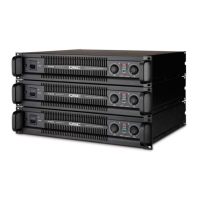PL3 Series Service Manual 19
TD-000274-00 Rev. A
thermal shutdown, is about 30 V DC. Feedback elements R160,
R157, Q45, and R153 provide stabilizing feedback to regulate the
fan voltage. R152 provides the reference current that sets the cold
or low-speed fan voltage.
• Fan failure or blockage will ultimately result in amplifier muting
once the heat sink temperatures reach about 80° C. This will
remove most sources of heat dissipation and prevent further
overheating.
• Q36 and Q39 diode-OR the THERM-A and THERM-B voltages
into a common bus called A/B_THERM.
Thermal Limiting and Muting
In the thermal sensing circuit (schematic: see sheet
“Amp Ch-A,
PL380,”
zone A-5), Q7’s emitter connects to a 4.48 V reference,
defined by R41, R42, and the +5V:LIN supply bus. When the heat
sink reaches about 75° C, the voltage on THERM-A decreases to
turn on Q7, which pulls the LIMITER-A control bus voltage positive,
activating the limiter circuitry to reduce the heat dissipation. If this
fails to arrest temperature rise, the amplifier will mute when the
heat sink reaches about 80° C.
Zobel Network Protection
The RC network on the output must be protected against dissipa-
tions that exceed the 200-watt rating of the resistors. When the
voltage on ZOB-A is excessive, it will turn on Q4, which pulls the
voltage positive on LIMITER-A.
Prolonged high frequency overloads will trigger muting, but if the
instability is due to component fault or abnormal load conditions,
runaway oscillations will promptly trigger muting via C224, R383,
R384, and Q83 pulling low bus A-MUTE-LO.
Prolonged Overcurrent Limiting
Overcurrent feedback via OC-FB-A into the modulator instantly
clamps peak currents, but the amplifier also needs to prevent
prolonged operation at such high levels. The output of the current
sensing network, OC-LIM-A, reaches a signal-rectifier circuit Q5 and
Q6, which pulls the LIMITER-A bus toward positive after several
seconds of peak output current.
Power Supply Current Limiting
Excessive long-term average power supply current triggers the bus
PS-LIM, which turns on Q79 on channel 1 and Q76 on channel 2.
Both channels limit simultaneously.
Clip Detection and Limiting
During normal switching, the modulator output is coupled via U6:4
through high frequency rectifiers D6 and D7 into C35, producing a
positive voltage on CLIP-A. When the channel clips, the modulation
has reached 100% and switching therefore stops. The voltage on
CLIP-A drops to zero, which triggers the Clip LED, and sends a 4 V
flag to the DataPort.
When the clip limiter switch on the rear panel is set to “off,” it
connects CL-A-ON to ground; when set to “enable” the clip limiter, it
is open and allows the falling voltage at CLIP-A to let Q72 turn on
and put limiter control current directly into R7 and R8. This bypasses
the relatively slow limiter bus, and acts rapidly on C228 and C257 to
produce prompt limiting of clip events.
DC Fault Shutdown System
The DC shutdown system (schematic: see sheet
“Protect/Control,
PL380”
zones A-4 and A-5) looks for significant DC offsets on either
channel and triggers a power supply shutdown in such an event.
Large DC voltages normally indicate a serious component fault such
as a shorted output device, and limiting the energy to the load and
through the output devices may prevent further damage.
Capacitor Overvoltage Protection
Prolonged output voltage of a given polarity may in rare occasions
result in current being drawn from one rail and flowing to the other
rail (thru the catch diodes) long enough to pump the off-side rail to
an excessively high voltage. The capacitor overvoltage protection
circuit (schematic: see sheet
“Protect/Control, PL380”
zones A-3 and
B-3) divides the rail voltages down to compare them with ±5 V
references. If either rail exceeds 225 V, the corresponding polarity of
the amplifier signal will be clamped by the op amps and diodes to
prevent further overvoltage.
If
both
rails exceed 225 V (corresponding to an approximately 22%
high AC mains line with no signal present), both clamps will
operate, probably quenching the signal altogether. However, the
amplifier should continue switching, which will maintain a load on
the supply capacitors. The power supply’s primary-side overvoltage
shutdown may also occur in this sort of situation.
Peripheral Signal-Processing Circuits
Many additional circuits, powered by the ±15 V rails, provide for
user adjustments, status displays, gain control, input buffering etc.
A brief orientation and review of these circuits follows.
Amplifier Balanced Inputs with Gain Adjustment
Op amps U21:1 and U22:1 (schematic: see sheet
“Inp-Displ, PL380”
)
are the input stages for channels 1 and 2, respectively. They are
arranged as differential amplfiers with precision 0.1% resistors to
maintain a very high common-mode noise rejection ratio.
A three-position switch allows the selection of different gain
structures, and an auxiliary set of contacts light corresponding
indicator LEDs and also provide an indicating voltage for remote
monitoring of the switch position.
Low Frequency Filters
The signal is padded by R322 and R323 to prevent full-scale signals’
overloading the input of op amp U21:2, which with components
C290, C291, C292, R334, and R335 make a switchable 30 Hz or
50 Hz, two-pole input filter. R327 and R337 restore the gain lost by
R322 and R323. Channel 2 has an identical arrangement.
2.2 PL380 Major Circuit Blocks (continued)

